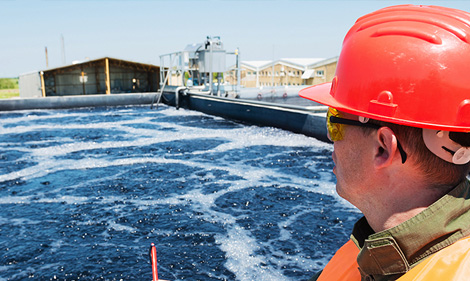

Water Transmission and Distribution

To deliver safe, attractive drinking water, science does not stop at the water plant. Distribution system operation and maintenance will also depend on system operators, engineers, hydraulics, chemistry, and more. There are many people to thank for successful water distribution: from the construction crew, to the maintenance and repair crew, to the certified system operators. Success is delivering a desirable product to the customer’s tap.
Systems consist of pumps, pipes, booster treatment pumps, storage/pressure tanks, and instrumentation. Pumps move the water from the source through the pipes and into the storage/pressure tanks. Instrumentation provides information on the water level in the tanks and system pressure. Water level indicates the available stored supply to the system. Pressure is important to efficiently deliver water to the customer as well as to exclude contaminants from entering the pipe through damaged walls or seals. Monitoring the pressure may also aid in detecting leaks. All these components are of different sizes and types and are chosen to meet each system’s individual needs.
Pumps are usually vertical turbine or horizontal centrifugal. The selection and sizing of water pumps are dictated by system requirements. Requirements included are flow capacity sufficient to meet system demands for volume (drinking, firefighting and industry), filling to the head (altitude) of stored water in elevated tanks and overcoming friction losses in pipes and fittings. Length and diameter of pipes are critical in in the final design of a system.
Usually system pipes are referred to as mains. Raw water mains deliver pumped water to the treatment facility for treatment and finished water storage. Finished water mains deliver pumped water to the public system for use in drinking, industry, and firefighting. Finished water mains consist of the main delivering to storage and branching into lateral mains to be tapped for connection to the end user. Pipes delivering clean water must be protected from contamination and corrosion. Corrosion control usually consists of keeping the finished water a slightly alkaline pH and the addition of sodium hexametaphosphate or other similar chemical. Contamination prevention usually depends on the water plant providing sufficient free chlorine residual to maintain a residual throughout the system. The residual may wane through long lines and may require remote booster chlorination to insure continued disinfection. Flushing mains at fire hydrants to clear out old water may also be implemented.
During assembly of water mains and replacement of damaged mains, strong emphasis should be toward well sealed pipe joints. Once the main is complete, still closed off from the system, it will be filled with water containing a chorine content of 50 mg/L and held for 24 hours. Just before this, or concurrently, a high pressure is introduced to the main section to determine if any leaks are present. The pressure gage is monitored for pressure loss, which will indicate a leak. No pressure loss indicates that no leaks are present. The main is then flushed out via hydrants or other outlets until the normal chlorine residual in the system is achieved. A total coliform bacteria analysis is performed. After a negative total coliform result and successful pressure/leak test is passed, the main can be put in service.
Elevated storage tanks or hydro pneumatic storage tanks are for storage and to provide system pressure. The high elevation of elevated tanks produces the pressure by providing system head. Hydro pneumatic tanks store water and deliver pressure by compressing air above the water as it is pumped. The installation and disinfection of tanks follow much of the same procedures as the installation of mains. Visible leaks are usually very evident and should be immediately corrected.
A complete system must still be monitored for total coliform bacteria and other contaminants. System chlorine residual and bacteria analysis indicates maintenance of disinfection.
These and other factors determine the correct construction, repair, and operation of the treatment and distribution systems. It is of extreme importance that system integrity is maintained to protect human health and provide the water needed for the community to use for drinking, firefighting, and industry.